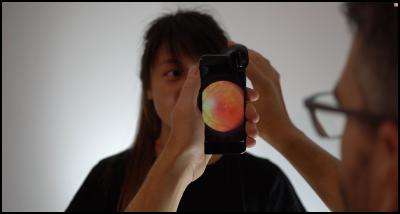World’s First Medical Device Initiative to Save Sight

Figure 1 – Retinal examination performed with oDocs visoscope, a smartphone retinal camera.
An award winning mobile innovation was launched by a oDocs Eye Care, a New Zealand based social enterprise. The company has introduced a set of smartphone-based devices that would allow healthcare providers to take photos of the human retina.
The company has promised to keep the inventions open-source, one of the very few altruistic motive to ensure that the products remain affordable and accessible. Furthermore, for every item sold, ten percent (10%) of the profit will be donated to a charity for sight.
oDocs is the brainchild of Dunedin Hospital-based ophthalmology registrar Dr. Hong Sheng Chiong and Dr. Benjamin O’Keeffe, senior house office of Ophthalmology department at Wellington Hospital. The social enterprise started this bold and ambitious project in 2014 and it took them 3 years of hard work and perseverance to materialise the innovations.
In May 2017, The New Zealand Hi-Tech Awards have just named oDocs Eye Care as New Zealand’s Most Innovative Mobile Technology company. The company has won numerous international awards including the prestigious Talent Unleashed Award judged by Sir Richard Branson, and Steve Wozniak.
“This is how disruption is done” said Steve Wozniak, co-founder of Apple.
Dr. Hong and his team have developed a smartphone retinal imaging adapter, also known as visoScope. When attached to an iPhone, the device converts the phone into a retinal camera. oDocs have also released a smartphone slit lamp microscope called visoClip.
“We have made them extremely affordable and accessible to benefit regions most in need. Conventional equipment would cost around US$ 20000 – 30000, whereas our devices cost a hundredth of that.” Said Dr. Hong.
The open-source devices are also compatible with 3D printing and additive manufacturing. Clinicians could just download the files from the web and 3D print the eye equipment locally, saving both cost and time from a logistic perspective.


 John Mazenier: Gaffer Tape And Glue Delivering New Zealand’s Mission Critical Services
John Mazenier: Gaffer Tape And Glue Delivering New Zealand’s Mission Critical Services Earthquake Commission: Ivan Skinner Award Winner Inspired By Real-life Earthquake Experience
Earthquake Commission: Ivan Skinner Award Winner Inspired By Real-life Earthquake Experience Reserve Bank: Consultation Opens On A Digital Currency For New Zealand
Reserve Bank: Consultation Opens On A Digital Currency For New Zealand NIWA: Ship Anchors May Cause Extensive And Long-lasting Damage To The Seafloor, According To New Research
NIWA: Ship Anchors May Cause Extensive And Long-lasting Damage To The Seafloor, According To New Research New Zealand Customs Service: A Step Forward For Simpler Trade Between New Zealand And Singapore
New Zealand Customs Service: A Step Forward For Simpler Trade Between New Zealand And Singapore Horizon Research: 68% Say Make Banks Offer Fraud Protection
Horizon Research: 68% Say Make Banks Offer Fraud Protection



